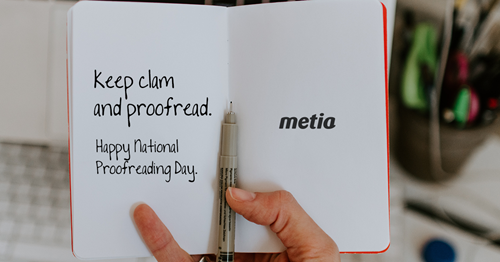Keep clam and proofread: Editorial best practices from the experts
08 March 2019
In honor of National Proofreading Day, I thought we needed some words of advice from our Editorial team. This blog was written by Ron Costarella, Senior Editor at Metia.
I think we can all agree that communication in the workplace is essential—and that includes written communication: articles, blogs, marketing copy, email, and on and on. Words matter. We strive for clarity, effectiveness, even elegance. And to strike the often-elusive right tone.
For all these reasons, it’s worth paying careful attention to our writerly selves. And though the following tips are offered from an editor’s perspective, it will be worth your while to keep them in mind as you write.
Why grammar, punctuation, and spelling matter.
First impressions are critical. Language reflects you and the company you represent and meaning can be affected.
- A woman without her man is nothing.
- A woman—without her, man is nothing.

Misconceptions about editing
- Editing is just about finding mistakes.
- Writers and editors have an adversarial relationship.
- All editors do the same thing
- Editor (developmental)
- Copyeditor (grammar, syntax)
- Proofreader (QA)
- Editing is a luxury.
Three types of editing:
- Substantive: Coherence, tone, flow—big-picture stuff
- Copyediting: Grammar, punctuation, syntax, spelling
- QA (a.k.a. proofreading): One last check to make sure no errors have crept in on the way to publishable form.
Getting inside the Editorial frame of mind
Editor checks for:
- Organization
- Coherence
- Tone
- Grammar and usage
- Branding
- Technical accuracy
Tips
- Close reading, no scanning. Read every word. Often, reading aloud (sotto voce) helps you hear problems in sentence structure, rhythm, etc.
- Question everything that’s not clear. Look up things you have a doubt about.
- Make sure the writing is polished.
- Be on the lookout for awkward, stilted wording
- Avoid clichés and, as best you can, jargon, which can be tenaciously favored by clients and customers.
- Transitions are important between sentences and between paragraphs: they’re essential to smoothly flowing text. Without them, sentences often read as nonsequiturs: Where did that come from? It doesn’t sound like it belongs here.

